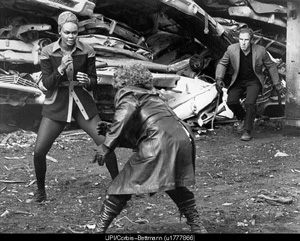The thread of African American history is spun from two sources: the struggle to define a place in the wider American life and the effort to maintain an authentic black presence in the larger American culture. This duality has meaning in the realm of filmmaking because the tools of cinema - film and cameras - cost more than the paper and pencil tools of writers. It is the cost of doing business that affects, indeed, threatens the black presence on the screen.
| Year | Performer | Category | Performance |
| 1939 | Hattie McDaniel | Best Supporting Actress | Gone With the Wind |
| 1947 | James Baskett | Special Award | Song of the South |
| 1963 | Sidney Poitier | Best Actor | Lilies of the Field |
| 1971 | Isaac Hayes | Best Song (from film) | "Theme from Shaft" - Shaft |
| 1978 | Paul Jabara | Best Song (from film) | "Last Dance" - Thank God It's Friday |
| 1982 | Louis Gossett, Jr. | Best Supporting Actor | An Officer and a Gentleman |
| 1984 | Stevie Wonder | Best Song (from film) | "I Just Called to Say I Love You" - The Woman in Red |
| 1985 | Lionel Richie | Best Song (from film) | "Say You, Say Me" - White Nights |
| 1986 | Herbie Hancock | Original Score | Round Midnight |
| 1989 | Denzel Washington | Best Supporting Actor | Glory |
| 1990 | Whoopi Goldberg | Best Supporting Actress | Ghost |

Often a black movie provides an anatomy of black cultural life, a glossary of style, patois, and politics, such as Michael Shultz's Car Wash (1976). Sometimes a so-called crossover movie finds an audience on both sides of the racial divide by drawing on a black cultural trait that speaks to black and white audiences. King Vidor's Hallelujah! (1929), for example, used the metaphor of a railroad train going to hell much as Eloyse Gist, the black evangelist, had done in her own Hell Bound Train, each conveying the same sense of pious urgency entwined with an almost erotic sensibility. In much the same way, Spike Lee, in his Do the Right Thing (1989), drew a crossover audience into a dramatic debate over what, indeed, the right political thing was. Sometimes a black-angled movie succeeds as a crossover because it successfully mingles cultures. For example, Marcel Camus's Orfeo Negro (1959) retold the Greek myth of Orpheus and Eurydice, set in the annual Afro-Brazilian Carnival (see Carnivals in Latin America and the Caribbean). In Trevor Rhone's The Harder They Come (1973), the reggae singer Jimmy Cliff plays a victim of a sleazy recording-industry boss. Driven to a life of outlawry, Cliff adopts a fantasy life of revenge in the mode of an American cowboy (not unlike Travis Bickle in Martin Scorsese's Taxi Driver). And in almost any Paul Robeson or Josephine Baker film of the 1930s, the theme involves a poignant outreach across racial cultures.
In any case, African American movies, whether so-called race movies made for black audiences or crossovers for a wider reach, arise from "the particular cultural conditions" (as the historian Gerald Mast wrote) of black life and history that surely "influence, if not dictate" the imagery and voice of black film. Therefore, the black critic James Snead has argued that a black cinema must "coin unconventional associations for black skin within the reigning film language" to replace well-known stereotypical images.